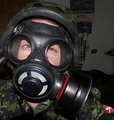Compression is good!
I uses it all the time at sport injurys!

Rice: rest, ice, compression, elevation
"RICE" is short for rest, ice, compression, and elevation. RICE started immediately after a minor injury can help to relieve the pain and keep the area from swelling. When there is an injury, fluid can collect in the area of the injury. This extra fluid causes swelling and, if there is enough extra fluid, the pain may worsen. RICE can be used for minor injuries such as bruises, sprains, strains, and pulled muscles. The earlier the RICE treatment is started after an injury, the better it works.
Rest the injured area. If moving the injured area causes pain, this is the body's way of saying stop. Rest the affected area. Do not use or bear weight (such as standing or walking) until evaluated by a healthcare provider. Sometimes resting an injured area means not participating in any physical activity or just the activity that caused the injury. For example, some walking may be allowed, but no running. If necessary, the provider may suggest using crutches or a cane so that less weight is put on the injured foot or leg.
Ice applied to the injured area will help to prevent or reduce swelling. Swelling causes more pain and can slow healing. Apply a cloth-covered ice pack to the injured area for no more than 20 minutes at a time, 4 to 8 times a day. A one-pound package of frozen corn or peas makes a good ice pack. It is lightweight, conforms to the injured area, and is inexpensive and reusable. Applying ice more than 20 minutes may cause cold injury. When making an ice pack with a plastic bag, make sure all the air is out of the bag before closing it. Areas with little fat and muscle, such as fingers or toes, should only have ice on them for about 10 minutes. Frozen gel packs are colder than ice, so they should only be left on for 10 minutes.
Compression (use of a pressure bandage) also helps to prevent or reduce swelling. Wrap the injured area with an elastic bandage, but not so tightly that the blood is cut off. It should not hurt or throb. Fingers or toes beyond the bandage should remain pink and not become "tingly." The elastic bandage should be taken off every 4 hours and reapplied.
Elevation means raising the injured area above the level of the heart. The affected part should be elevated so it is 12 inches above the heart, to help reduce swelling. Prop up a leg or arm while resting it. It may be necessary to lie down to get the leg above the heart level. Elevation can be done with several pillows.
Anyone with Raynaud's, diabetes, sensitivity to cold or any medical condition with reduced blood flow to the arms or legs should not use RICE therapy. These people need to see their provider for care of minor and more serious injuries.
Do all 4 parts of the RICE treatment together. If there is still pain when using the injured part after 1 or 2 days, see a healthcare provider. If the injury is serious, such as internal bleeding or a broken bone, do not wait! See a healthcare provider immediately, or go directly to the emergency department.

















 Bar by Mees
Bar by Mees

